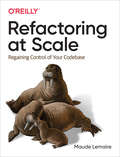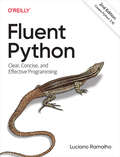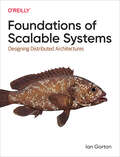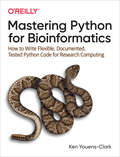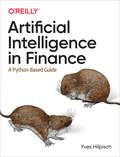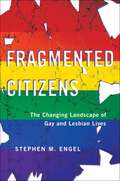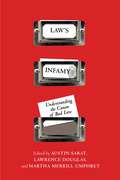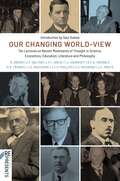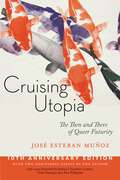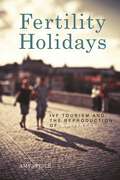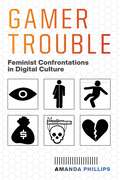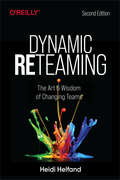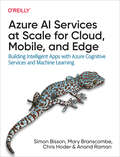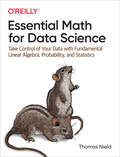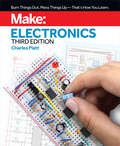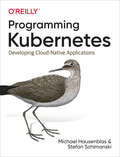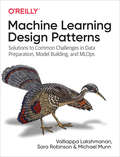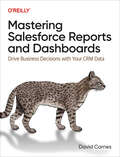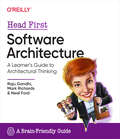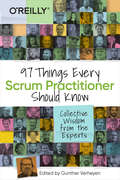- Table View
- List View
Refactoring at Scale: Regaining Control Of Your Codebase
by Maude LemaireMaking significant changes to large, complex codebases is a daunting task--one that's nearly impossible to do successfully unless you have the right team, tools, and mindset. If your application is in need of a substantial overhaul and you're unsure how to go about implementing those changes in a sustainable way, then this book is for you.Software engineer Maude Lemaire walks you through the entire refactoring process from start to finish. You'll learn from her experience driving performance and refactoring efforts at Slack during a period of critical growth, including two case studies illustrating the impact these techniques can have in the real world. This book will help you achieve a newfound ability to productively introduce important changes in your codebase.Understand how code degrades and why some degradation is inevitableQuantify and qualify the state of your codebase before refactoringDraft a well-scoped execution plan with strategic milestonesWin support from engineering leadershipBuild and coordinate a team best suited for the projectCommunicate effectively inside and outside your teamAdopt best practices for successfully executing the refactor
Fluent Python: Clear, Concise, and Effective Programming
by Luciano RamalhoDon't waste time bending Python to fit patterns you've learned in other languages. Python's simplicity lets you become productive quickly, but often this means you aren't using everything the language has to offer. With the updated edition of this hands-on guide, you'll learn how to write effective, modern Python 3 code by leveraging its best ideas.Discover and apply idiomatic Python 3 features beyond your past experience. Author Luciano Ramalho guides you through Python's core language features and libraries and teaches you how to make your code shorter, faster, and more readable.Complete with major updates throughout, this new edition features five parts that work as five short books within the book:Data structures: Sequences, dicts, sets, Unicode, and data classesFunctions as objects: First-class functions, related design patterns, and type hints in function declarationsObject-oriented idioms: Composition, inheritance, mixins, interfaces, operator overloading, protocols, and more static typesControl flow: Context managers, generators, coroutines, async/await, and thread/process poolsMetaprogramming: Properties, attribute descriptors, class decorators, and new class metaprogramming hooks that replace or simplify metaclasses
Foundations of Scalable Systems: Designing Distributed Architectures
by Ian GortonIn many systems, scalability becomes the primary driver as the user base grows. Attractive features and high utility breed success, which brings more requests to handle and more data to manage. But organizations reach a tipping point when design decisions that made sense under light loads suddenly become technical debt. This practical book covers design approaches and technologies that make it possible to scale an application quickly and cost-effectively.Author Ian Gorton takes software architects and developers through the foundational principles of distributed systems. You'll explore the essential ingredients of scalable solutions, including replication, state management, load balancing, and caching. Specific chapters focus on the implications of scalability for databases, microservices, and event-based streaming systems.You will focus on:Foundations of scalable systems: Learn basic design principles of scalability, its costs, and architectural tradeoffsDesigning scalable services: Dive into service design, caching, asynchronous messaging, serverless processing, and microservicesDesigning scalable data systems: Learn data system fundamentals, NoSQL databases, and eventual consistency versus strong consistencyDesigning scalable streaming systems: Explore stream processing systems and scalable event-driven processing
Mastering Python for Bioinformatics: How To Write Flexible, Documented, Tested Python Code For Research Computing
by Ken Youens-ClarkLife scientists today urgently need training in bioinformatics skills. Too many bioinformatics programs are poorly written and barely maintained, usually by students and researchers who've never learned basic programming skills. This practical guide shows postdoc bioinformatics professionals and students how to exploit the best parts of Python to solve problems in biology while creating documented, tested, reproducible software.Ken Youens-Clark, author of Tiny Python Projects (Manning), demonstrates not only how to write effective Python code but also how to use tests to write and refactor scientific programs. You'll learn the latest Python features and tools including linters, formatters, type checkers, and tests to create documented and tested programs. You'll also tackle 14 challenges in Rosalind, a problem-solving platform for learning bioinformatics and programming.Create command-line Python programs to document and validate parametersWrite tests to verify refactor programs and confirm they're correctAddress bioinformatics ideas using Python data structures and modules such as BiopythonCreate reproducible shortcuts and workflows using makefilesParse essential bioinformatics file formats such as FASTA and FASTQFind patterns of text using regular expressionsUse higher-order functions in Python like filter(), map(), and reduce()
Artificial Intelligence in Finance: A Python-based Guide
by Yves HilpischThe widespread adoption of AI and machine learning is revolutionizing many industries today. Once these technologies are combined with the programmatic availability of historical and real-time financial data, the financial industry will also change fundamentally. With this practical book, you'll learn how to use AI and machine learning to discover statistical inefficiencies in financial markets and exploit them through algorithmic trading.Author Yves Hilpisch shows practitioners, students, and academics in both finance and data science practical ways to apply machine learning and deep learning algorithms to finance. Thanks to lots of self-contained Python examples, you'll be able to replicate all results and figures presented in the book.In five parts, this guide helps you:Learn central notions and algorithms from AI, including recent breakthroughs on the way to artificial general intelligence (AGI) and superintelligence (SI)Understand why data-driven finance, AI, and machine learning will have a lasting impact on financial theory and practiceApply neural networks and reinforcement learning to discover statistical inefficiencies in financial marketsIdentify and exploit economic inefficiencies through backtesting and algorithmic trading--the automated execution of trading strategiesUnderstand how AI will influence the competitive dynamics in the financial industry and what the potential emergence of a financial singularity might bring about
Fragmented Citizens: The Changing Landscape of Gay and Lesbian Lives
by Stephen M. EngelA sweeping historical and political account of how our present-day policy debates around citizenship and equality came to beThe landmark Supreme Court decision in June 2015 legalizing the right to same-sex marriage marked a major victory in gay and lesbian rights in the United States. Once subject to a patchwork of laws granting legal status to same-sex couples in some states and not others, gay and lesbian Americans now enjoy full legal status for their marriages wherever they travel or reside in the country. For many, the Supreme Court’s ruling means that gay and lesbian citizens are one step closer to full equality with the rest of America. In Fragmented Citizens, Stephen M. Engel contends that the present moment in gay and lesbian rights in America is indeed one of considerable advancement and change—but that there is still much to be done in shaping American institutions to recognize gays and lesbians as full citizens. With impressive scope and fascinating examples, Engel traces the relationship between gay and lesbian individuals and the government from the late nineteenth century through the present. Engel shows that gays and lesbians are more accurately described as fragmented citizens. Despite the marriage ruling, Engel argues that LGBT Americans still do not have full legal protections against workplace, housing, family, and other kinds of discrimination. There remains a continuing struggle of the state to control the sexuality of gay and lesbian citizens—they continue to be fragmented citizens. Engel argues that understanding the development of the idea of gay and lesbian individuals as ‘less-than-whole’ citizens can help us make sense of the government’s continued resistance to full equality despite massive changes in public opinion. Furthermore, he argues that it was the state’s ability to identify and control gay and lesbian citizens that allowed it to develop strong administrative capacities to manage all of its citizens in matters of immigration, labor relations, and even national security. The struggle for gay and lesbian rights, then, affected not only the lives of those seeking equality but also the very nature of American governance itself. Fragmented Citizens is a sweeping historical and political account of how our present-day policy debates around citizenship and equality came to be.
Law's Infamy: Understanding the Canon of Bad Law
by UnknownAn analysis of how problematic laws ought to be framed and consideredFrom the murder of George Floyd to the systematic dismantling of voting rights, our laws and their implementation are actively shaping the course of our nation. But however abhorrent a legal decision might be—whether Dred Scott v. Sanford or Plessy v. Ferguson—the stories we tell of the law’s failures refer to their injustice and rarely label them in the language of infamy. Yet in many instances, infamy is part of the story law tells about citizens’ conduct. Such stories of individual infamy work on both the social and legal level to stigmatize and ostracize people, to mark them as unredeemably other. Law’s Infamy seeks to alter that course by making legal actions and decisions the subject of an inquiry about infamy. Taken together, the essays demonstrate how legal institutions themselves engage in infamous actions and urge that scholars and activists label them as such, highlighting the damage done when law itself acts infamously and focus of infamous decisions that are worthy of repudiation. Law's Infamy asks when and why the word infamy should be used to characterize legal decisions or actions. This is a much-needed addition to the broader conversation and questions surrounding law’s complicity in evil.
Wanamaker's Temple: The Business of Religion in an Iconic Department Store
by Nicole C. KirkHow a pioneering merchant blended religion and business to create a unique American shopping experienceOn Christmas Eve, 1911, John Wanamaker stood in the middle of his elaborately decorated department store building in Philadelphia as shoppers milled around him picking up last minute Christmas presents. On that night, as for years to come, the store was filled with the sound of Christmas carols sung by thousands of shoppers, accompanied by the store’s Great Organ. Wanamaker recalled that moment in his diary, “I said to myself that I was in a temple,” a sentiment quite possibly shared by the thousands who thronged the store that night.Remembered for his store’s extravagant holiday decorations and displays, Wanamaker built one of the largest retailing businesses in the world and helped to define the American retail shopping experience. From the freedom to browse without purchase and the institution of one price for all customers to generous return policies, he helped to implement retailing conventions that continue to define American retail to this day. Wanamaker was also a leading Christian leader, participating in the major Protestant moral reform movements from his youth until his death in 1922. But most notably, he found ways to bring his religious commitments into the life of his store. He focused on the religious and moral development of his employees, developing training programs and summer camps to build their character, while among his clientele he sought to cultivate a Christian morality through decorum and taste.Wanamaker’s Temple examines how and why Wanamaker blended business and religion in his Philadelphia store, offering a historical exploration of the relationships between religion, commerce, and urban life in the late nineteenth and early twentieth century and illuminating how they merged in unexpected and public ways. Wanamaker's marriage of religion and retail had a pivotal role in the way American Protestantism was expressed and shaped in American life, and opened a new door for the intertwining of personal values with public commerce.
Our Changing World-View: Ten Lectures on Recent Movements of Thought in Science, Economics, Education, Literature and Philosophy
by Jan Christian Smuts John Patrick Dalton Robert Broom John Frederick Phillips Ian D MacCrone John Young Greig Theodorus Johannes Haarhof Cecil Sydney Richards Sally Herbert Frankel Reinhold Frederick HoernléJohannesburg was still a brash mining town, better known for the production of wealth than knowledge, and the University of the Witwatersrand a mere ten years old when, in 1932, these ten lectures were delivered under the auspices of the University Philosophical Society. They portrayed the ideas of the university’s leading academics of the day, and the programme of lectures reveals a studied effort to introduce an element of bipartisan political representation between English and Afrikaner in South Africa by including Wits’ first principal, Jan Hofmeyr, and politician, D.F. Malan, as discussion chairs. Yet, no black intellectuals were represented and, indeed, the politics of racial segregation bursts through the text only in a few of the contributions. For the most part, race is alluded to only in passing.As Saul Dubow explains in his new introduction to this re-issue of the lectures, Our Changing World-View was an occasion for Wits’ leading faculty members to position the young university as a mature institution with a leadership role in public affairs. Above all, it was a means to project the university as a research as well as a teaching institution, led by a vigorous and ambitious cohort of liberal-minded intellectuals. That all were male and white will be immediately apparent to readers of this reissued volume. Ranging from economics, psychology, a spurious rebuttal of evolution to a substantial revisionist history and the perils of the ‘machine age’, this book is a sombre reflection of intellectual history and the academy’s role in promulgating political and social divisions in South Africa.
Cruising Utopia, 10th Anniversary Edition: The Then and There of Queer Futurity (Sexual Cultures #50)
by José Esteban MuñozA 10th anniversary edition of this field defining work—an intellectual inspiration for a generation of LGBTQ scholars Cruising Utopia arrived in 2009 to insist that queerness must be reimagined as a futurity-bound phenomenon, an insistence on the potentiality of another world that would crack open the pragmatic present. Part manifesto, part love-letter to the past and the future, José Esteban Muñoz argued that the here and now were not enough and issued an urgent call for the revivification of the queer political imagination.On the anniversary of its original publication, this edition includes two essays that extend and expand the project of Cruising Utopia, as well as a new foreword by the current editors of Sexual Cultures, the book series he co-founded with Ann Pellegrini 20 years ago. This 10th anniversary edition celebrates the lasting impact that Cruising Utopia has had on the decade of queer of color critique that followed and introduces a new generation of readers to a future not yet here.
The Black Radical Tragic: Performance, Aesthetics, and the Unfinished Haitian Revolution (America and the Long 19th Century #2)
by Jeremy Matthew Glick2017 Nicolás Guillén Outstanding Book Award presented by the Caribbean Philosophical AssociationAs the first successful revolution emanating from a slave rebellion, the Haitian Revolution remains an inspired site of investigation for a remarkable range of artists and activist-intellectuals in the African Diaspora.In The Black Radical Tragic, Jeremy Matthew Glick examines twentieth-century performances engaging the revolution as laboratories for political thinking. Asking readers to consider the revolution less a fixed event than an ongoing and open-ended history resonating across the work of Atlantic world intellectuals, Glick argues that these writers use the Haitian Revolution as a watershed to chart their own radical political paths, animating, enriching, and framing their artistic and scholarly projects. Spanning the disciplines of literature, philosophy, and political thought, The Black Radical Tragic explores work from Lorraine Hansberry, Sergei Eisenstein, Edouard Glissant, Malcolm X, and others, ultimately enacting a speculative encounter between Bertolt Brecht and C.L.R. James to reconsider the relationship between tragedy and revolution. In its grand refusal to forget, The Black Radical Tragic demonstrates how the Haitian Revolution has influenced the ideas of freedom and self-determination that have propelled Black radical struggles throughout the modern era.
Fertility Holidays: IVF Tourism and the Reproduction of Whiteness
by Amy SpeierA critical analysis of white, working class North Americans’ motivations and experiences when traveling to Central Europe for donor egg IVFEach year, more and more Americans travel out of the country seeking low cost medical treatments abroad, including fertility treatments such as in vitro fertilization (IVF). As the lower middle classes of the United States have been priced out of an expensive privatized “baby business,” the Czech Republic has emerged as a central hub of fertility tourism, offering a plentitude of blonde-haired, blue-eyed egg donors at a fraction of the price.Fertility Holidays presents a critical analysis of white, working class North Americans’ motivations and experiences when traveling to Central Europe for donor egg IVF. Within this diaspora, patients become consumers, urged on by the representation of a white Europe and an empathetic health care system, which seems nonexistent at home. As the volume traces these American fertility journeys halfway around the world, it uncovers layers of contradiction embedded in global reproductive medicine. Speier reveals the extent to which reproductive travel heightens the hope ingrained in reproductive technologies, especially when the procedures are framed as “holidays.” The pitch of combining a vacation with their treatment promises couples a stress-free IVF cycle; yet, in truth, they may become tangled in fraught situations as they endure an emotionally wrought cycle of IVF in a strange place.Offering an intimate, first-hand account of North Americans’ journeys to the Czech Republic for IVF, Fertility Holidays exposes reproductive travel as a form of consumption which is motivated by complex layers of desire for white babies, a European vacation, better health care, and technological success.
Immigrants Under Threat: Risk and Resistance in Deportation Nation (Latina/o Sociology #5)
by Greg PrietoCo-Winner, 2019 Latina/o Section Distinguished Contribution to Research Book Award, given by the American Sociological AssociationA portrait of two Mexican immigrant communities confronting threats of deportation, detention, and dispossession Everyday life as an immigrant in a deportation nation is fraught with risk, but everywhere immigrants confront repression and dispossession, they also manifest resistance in ways big and small. Immigrants Under Threat shifts the conversation from what has been done to Mexican immigrants to what they do in response. From private strategies of avoidance, to public displays of protest, immigrant resistance is animated by the massive demographic shifts that started in 1965 and an immigration enforcement regime whose unprecedented scope and intensity has made daily life increasingly perilous. Immigrants Under Threat focuses on the way the material needs of everyday life both enable and constrain participation in immigrant resistance movements. Using ethnographic research from two Mexican immigrant communities on California’s Central Coast, Greg Prieto argues that immigrant communities turn inward to insulate themselves from the perceived risks of authorities and a hostile public. These barriers are overcome through the face-to-face work of social-movement organizing that transforms individual grievances into collective demands. The social movements that emerge are shaped by the local political climates in which they unfold and remain tethered to their material inspiration. Immigrants Under Threat explains that Mexican immigrants seek not to transcend, but to burrow into American institutions of law and family so that they might attain a measure of economic stability and social mobility that they have sought all along.
Gamer Trouble: Feminist Confrontations in Digital Culture
by Amanda PhillipsComplicating perspectives on diversity in video gamesGamers have been troublemakers as long as games have existed. As our popular understanding of “gamer” shifts beyond its historical construction as a white, straight, adolescent, cisgender male, the troubles that emerge both confirm and challenge our understanding of identity politics. In Gamer Trouble, Amanda Phillips excavates the turbulent relationships between surface and depth in contemporary gaming culture, taking readers under the hood of the mechanisms of video games in order to understand the ways that difference gets baked into its technological, ludic, ideological, and social systems.By centering the insights of queer and women of color feminisms in readings of online harassment campaigns, industry animation practices, and popular video games like Portal and Mass Effect, Phillips adds essential analytical tools to our conversations about video games. She embraces the trouble that attends disciplinary crossroads, linking the violent hate speech of trolls and the representational practices marginalizing people of color, women, and queers in entertainment media to the dehumanizing logic undergirding computation and the optimization strategies of gameplay. From the microcosmic level of electricity and flicks of a thumb to the grand stages of identity politics and global capitalism, wherever gamers find themselves, gamer trouble follows. As reinvigorated forms of racism, sexism, and homophobia thrive in games and gaming communities, Phillips follows the lead of those who have been making good trouble all along, agitating for a better world.
Reproductive Injustice: Racism, Pregnancy, and Premature Birth (Anthropologies of American Medicine: Culture, Power, and Practice #7)
by Dána-Ain DavisWinner, 2020 Senior Book Prize, given by the Association of Feminist AnthropologyWinner, 2020 Eileen Basker Memorial Prize, given by the Society for Medical AnthropologyHonorable Mention, 2020 Victor Turner Prize in Ethnographic Writing, given by the Society for Humanistic AnthropologyFinalist, 2020 PROSE Award in the Sociology, Anthropology and Criminology category, given by the Association of American PublishersA troubling study of the role that medical racism plays in the lives of Black women who have given birth to premature and low birth weight infantsBlack women have higher rates of premature birth than other women in America. This cannot be simply explained by economic factors, with poorer women lacking resources or access to care. Even professional, middle-class Black women are at a much higher risk of premature birth than low-income white women in the United States. Dána-Ain Davis looks into this phenomenon, placing racial differences in birth outcomes into a historical context, revealing that ideas about reproduction and race today have been influenced by the legacy of ideas which developed during the era of slavery.While poor and low-income Black women are often the “mascots” of premature birth outcomes, this book focuses on professional Black women, who are just as likely to give birth prematurely. Drawing on an impressive array of interviews with nearly fifty mothers, fathers, neonatologists, nurses, midwives, and reproductive justice advocates, Dána-Ain Davis argues that events leading up to an infant’s arrival in a neonatal intensive care unit (NICU), and the parents’ experiences while they are in the NICU, reveal subtle but pernicious forms of racism that confound the perceived class dynamics that are frequently understood to be a central factor of premature birth.The book argues not only that medical racism persists and must be considered when examining adverse outcomes—as well as upsetting experiences for parents—but also that NICUs and life-saving technologies should not be the only strategies for improving the outcomes for Black pregnant women and their babies. Davis makes the case for other avenues, such as community-based birthing projects, doulas, and midwives, that support women during pregnancy and labor are just as important and effective in avoiding premature births and mortality.
Dynamic Reteaming: The Art and Wisdom of Changing Teams
by Heidi HelfandYour team will change whether you like it or not. People will come and go. Your company might double in size or even be acquired. In this practical book, author Heidi Helfand shares techniques for reteaming effectively. Engineering leaders will learn how to catalyze team change to reduce the risk of attrition, learning and career stagnation, and the development of knowledge silos.Based on research into well-known software companies, the patterns in this book help CTOs and team managers effectively integrate new hires into an existing team, manage a team that has lost members, or deal with unexpected change. You’ll learn how to isolate teams for focused innovation, rotate team members for knowledge sharing, break through organizational apathy, and more.You’ll explore:Real-world examples that demonstrate why and how organizations reteamFive reteaming patterns: One by One, Grow and Split, Isolation, Merging, and SwitchingTactics to help you master dynamic reteaming in your companyStories that demonstrate problems caused by reteaming anti-patterns
Azure AI Services at Scale for Cloud, Mobile, and Edge: Building Intelligent Apps with Azure Cognitive Services and Machine Learning
by Simon Bisson Mary Branscombe Chris Hoder Anand RamanTake advantage of the power of cloud and the latest AI techniques. Whether you're an experienced developer wanting to improve your app with AI-powered features or you want to make a business process smarter by getting AI to do some of the work, this book's got you covered. Authors Anand Raman, Chris Hoder, Simon Bisson, and Mary Branscombe show you how to build practical intelligent applications for the cloud, mobile, browsers, and edge devices using a hands-on approach.This book shows you how cloud AI services fit in alongside familiar software development approaches, walks you through key Microsoft AI services, and provides real-world examples of AI-oriented architectures that integrate different Azure AI services. All you need to get started is a working knowledge of basic cloud concepts.Become familiar with Azure AI offerings and capabilitiesBuild intelligent applications using Azure Cognitive ServicesTrain, tune, and deploy models with Azure Machine Learning, PyTorch, and the Open Neural Network Exchange (ONNX)Learn to solve business problems using AI in the Power PlatformUse transfer learning to train vision, speech, and language models in minutes
Essential Math for Data Science: Take Control of Your Data with Fundamental Linear Algebra, Probability, and Statistics
by Thomas NieldMaster the math needed to excel in data science, machine learning, and statistics. In this book author Thomas Nield guides you through areas like calculus, probability, linear algebra, and statistics and how they apply to techniques like linear regression, logistic regression, and neural networks. Along the way you'll also gain practical insights into the state of data science and how to use those insights to maximize your career.Learn how to:Use Python code and libraries like SymPy, NumPy, and scikit-learn to explore essential mathematical concepts like calculus, linear algebra, statistics, and machine learningUnderstand techniques like linear regression, logistic regression, and neural networks in plain English, with minimal mathematical notation and jargonPerform descriptive statistics and hypothesis testing on a dataset to interpret p-values and statistical significanceManipulate vectors and matrices and perform matrix decompositionIntegrate and build upon incremental knowledge of calculus, probability, statistics, and linear algebra, and apply it to regression models including neural networksNavigate practically through a data science career and avoid common pitfalls, assumptions, and biases while tuning your skill set to stand out in the job market
Make: Learning by Discovery: A hands-on primer for the new electronics enthusiast
by Charles PlattMake: Electronics explores the properties and applications of discrete components that are the fundamental building blocks of circuit design. Understanding resistors, capacitors, transistors, inductors, diodes, and integrated circuit chips is essential even when using microcontrollers. Make: Electronics teaches the fundamentals and also provides advice on the tools and supplies that are necessary. Component kits are available, specifically developed for the third edition.
Networking and Kubernetes: A Layered Approach
by James Strong Vallery LanceyKubernetes has become an essential part of the daily work for most system, network, and cluster administrators today. But to work effectively together on a production-scale Kubernetes system, they must be able to speak the same language. This book provides a clear guide to the layers of complexity and abstraction that come with running a Kubernetes network.Authors James Strong and Vallery Lancey bring you up to speed on the intricacies that Kubernetes has to offer for large container deployments. If you're to be effective in troubleshooting and maintaining a production cluster, you need to be well versed in the abstraction provided at each layer. This practical book shows you how.Learn the Kubernetes networking modelChoose the best interface for your clusters from the CNCF Container Network Interface projectExplore the networking and Linux primitives that power KubernetesQuickly troubleshoot networking issues and prevent downtimeExamine cloud networking and Kubernetes using the three major providers: Amazon Web Services, Google Cloud, and Microsoft AzureLearn the pros and cons of various network tools--and how to select the best ones for your stack
Programming Kubernetes: Developing Cloud-Native Applications
by Michael Hausenblas Stefan SchimanskiIf you’re looking to develop native applications in Kubernetes, this is your guide. Developers and AppOps administrators will learn how to build Kubernetes-native applications that interact directly with the API server to query or update the state of resources. AWS developer advocate Michael Hausenblas and Red Hat principal software engineer Stefan Schimanski explain the characteristics of these apps and show you how to program Kubernetes to build them.You’ll explore the basic building blocks of Kubernetes, including the client-go API library and custom resources. All you need to get started is a rudimentary understanding of development and system administration tools and practices, such as package management, the Go programming language, and Git.Walk through Kubernetes API basics and dive into the server’s inner structureExplore Kubernetes’s programming interface in Go, including Kubernetes API objectsLearn about custom resources—the central extension tools used in the Kubernetes ecosystemUse tags to control Kubernetes code generators for custom resourcesWrite custom controllers and operators and make them production readyExtend the Kubernetes API surface by implementing a custom API server
Machine Learning Design Patterns
by Michael Munn Valliappa Lakshmanan Sara RobinsonThe design patterns in this book capture best practices and solutions to recurring problems in machine learning. The authors, three Google engineers, catalog proven methods to help data scientists tackle common problems throughout the ML process. These design patterns codify the experience of hundreds of experts into straightforward, approachable advice.In this book, you will find detailed explanations of 30 patterns for data and problem representation, operationalization, repeatability, reproducibility, flexibility, explainability, and fairness. Each pattern includes a description of the problem, a variety of potential solutions, and recommendations for choosing the best technique for your situation.You'll learn how to:Identify and mitigate common challenges when training, evaluating, and deploying ML modelsRepresent data for different ML model types, including embeddings, feature crosses, and moreChoose the right model type for specific problemsBuild a robust training loop that uses checkpoints, distribution strategy, and hyperparameter tuningDeploy scalable ML systems that you can retrain and update to reflect new dataInterpret model predictions for stakeholders and ensure models are treating users fairly
Mastering Salesforce Reports and Dashboards: Drive Business Decisions with Your CRM Data
by David CarnesEffective, repeatable, and insightful analytics are key to ROI in customer relationship management systems. Many organizations, however, lack the automated reporting tools they need to run their businesses and instead choose to massage the data in Excel. But there's a better way. Salesforce's standard reporting tools provide a rich set of features that, when combined, support a wide variety of analytics needs.This practical introduction covers all the aspects and features you need to be successful with Salesforce reports and dashboards. Author David Carnes, chairman and chief evangelist for OpFocus, shows executives, end users, and report and dashboard superusers what analytics are possible, which features report writers should ask to be enabled, and which settings and permissions system administrators need to activate.You'll learn:How to create reports using the four main report formats in SalesforceHow to create and use dashboardsMethods for storing and finding reports and dashboardsHow to leverage formulas and trending in Salesforce reportingSpecial reporting features only available in Salesforce Mobile and on the Analytics tabWays to embed report charts and dashboards in Lightning page layoutsPowerful combinations of reporting features to drive decisions
Head First Software Architecture: A Learner's Guide to Architectural Thinking
by Neal Ford Mark Richards Raju GandhiWhat will you learn from this book?If you're a software developer looking for a quick on-ramp to software architecture, this handy guide is a great place to start. From the authors of Fundamentals of Software Architecture, Head First Software Architecture teaches you how to think architecturally and explores the unique challenges of software architecture. You'll learn the distinction between architecture and design and the relationship between code, components, and architectural styles. You'll also learn how to work with some common architectural styles through vivid, fun examples. Quick, easy, and entertaining, this book is a valuable introduction to the world of software architecture.Why does this book look so different?Based on the latest research in cognitive science and learning theory, Head First Software Architecture uses a visually rich format to engage your mind, rather than a text-heavy approach that puts you to sleep. Why waste your time struggling with new concepts? This multisensory learning experience is designed for the way your brain really works.
97 Things Every Scrum Practitioner Should Know: Collective Wisdom from the Experts
by Gunther VerheyenImprove your understanding of Scrum through the proven experience and collected wisdom of experts around the world. Based on real-life experiences, the 97 essays in this unique book provide a wealth of knowledge and expertise from established practitioners who have dealt with specific problems and challenges with Scrum.You'll find out more about the rules and roles of this framework, as well as tactics, strategies, specific patterns to use with Scrum, and stories from the trenches. You'll also gain insights on how to apply, tune, and tweak Scrum for your work. This guide is an ideal resource for people new to Scrum and those who want to assess and improve their understanding of this framework."Scrum Is Simple. Just Use It As Is.," Ken Schwaber"The 'Standing Meeting,'" Bob Warfield"Specialization Is for Insects," James O. Coplien"Scrum Events Are Rituals to Ensure Good Harvest," Jasper Lamers"Servant Leadership Starts from Within," Bob Galen"Agile Is More than Sprinting," James W. Grenning
